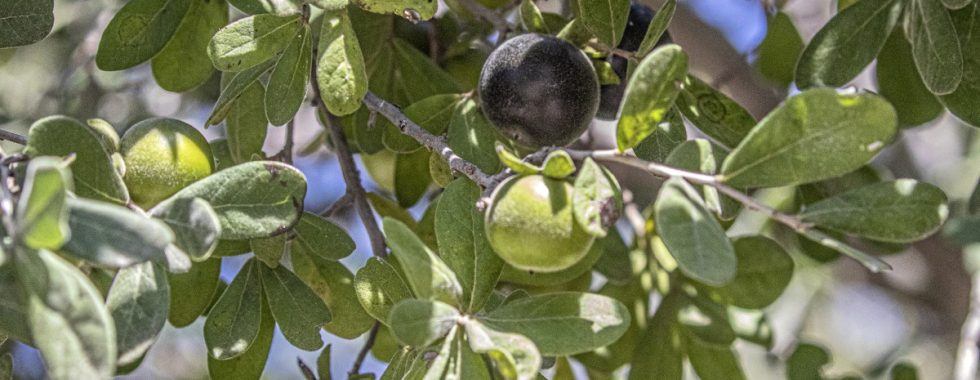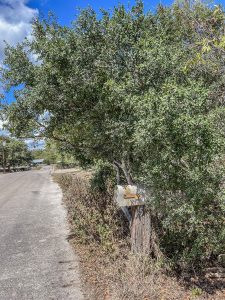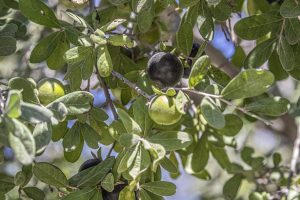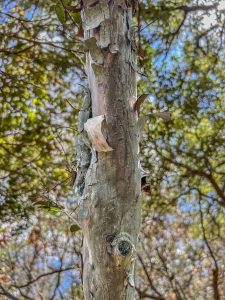Trail Notes: In Praise of the Chapote
Three months of little to no rain, along with roughly eighty 100-plus-degree days, have shone a bright spotlight on those Texas natives that are well-adapted to heat and drought. Some of these, such as huisache and guajillo, were featured in the last edition of The Loop. One standout not mentioned, however, was the Texas or Mexican persimmon (Diospyros texana), a tree that has proven successful in both our natural areas and home landscapes.
Writing in the Oct. 2004 issue of Ranch and Rural Living, retired Extension Agent Jake Landers admitted, “I have described Texas persimmon in the past as the toughest, most persistent shrub in the hill country, that it has resisted herbicides, survived fire, wind, ice, drought, flood, sun, and goats, and resprouts vigorously when mechanically bothered. I still think that.” Also known as chapote, the Texas persimmon was called “one of Texas’ premiere small trees” by the late Benny Simpson, co-founder of the Texas Native Plant Society. Each man’s assessment is well-earned.
Prized for both its fruit and its bark, this relative of the ebony tree can grow in our thinnest, rockiest soil, in either sun or shade. And its small, leathery leaves equip it perfectly for our hot, dry summers. The Texas persimmon is a trooper.
The tree’s fruit, a 1-inch ball that morphs from green to black when ripe, has been enjoyed by humans and wildlife for millennia. When it’s in bloom, anytime from February through April, the tree’s fragrant white flowers are a magnet for bees and other pollinators. Because the species is dioecious, meaning that individual trees are either male or female, it’s a trick to know which sex you have. Botanist Damon Waitt, former director of the Lady Bird Johnson Wildflower Center, offers this hint: “You can tell male trees from female trees because male flowers are smaller and appear in small clusters, while the larger female flower appears alone.” I make this determination in a less scientific way: The 15-foot tree by the mailbox is a girl because it’s covered in fruit, while the tree on the other side of the driveway is barren and therefore a boy. I use a similar approach in late summer or early fall to decide when the fruit is ripe: a blackish-purple stain appears on the street below the mailbox.
Naturalist Matt Warnock Turner, in his book Remarkable Plants of Texas: Uncommon Accounts of our Common Natives, describes just how tenacious that color can be. “The stain is put to good use as a dye,” he writes, “and Mexican and Texas Hispanics alike dyed leather, sheep- and goatskins, and even their hair with the fruit or, occasionally, with the seeds. . . . There is even a report of the fruit’s use as an ink.”
It’s the persimmon’s taste, though, that gets the most praise. Described by some as “like a sweet prune,” the fruit has been part of the human diet since about 7000 BCE, a fact established by archeologists studying ancient cooking pits in Val Verde County. According to Turner, it was eaten by both the coastal Karankawa Indians and the Comanches. “The famed early nineteenth-century botanical explorer Jean Louis Berlandier mentions that the chapote was ‘greatly esteemed’ along the Frio River south of San Antonio,” Turner writes, “and the mid-nineteenth-century explorer Viktor Bract says a tasty preserve was made from it . . . .” Indeed, not just preserves but also jams and jellies, puddings, pastries, and even wine can be created by anyone with the energy and perseverance to separate the juice and pulp from the skin and seeds. Eating the fruit raw is an equally messy proposition, and the tannins it contains can be a problem for some people.
Though persimmon fruit can cause digestive complications in cattle, most animals have no such issues. Indeed, the list of species that feed on it in the fall is long: javelina, turkeys, ringtails, foxes, deer, coyote, raccoon. I wonder daily what the wildlife who visit our yard are finding to eat during these lean times. How, for example, can the adolescent raccoons that show up for water each night possibly be so fat? Then I think of the myriad persimmon trees on our property. The raccoons are no doubt eating their fill.
Birds, too, will feed on the fruit of the persimmon. These species include not just turkeys, but also yellow-rumped warblers, cedar waxwings, catbirds, robins, pileated woodpeckers, and mockingbirds. Thanks to its dense foliage, the tree likewise provides good cover for these and other birds and serves as larval host for gray hairstreak and Henry’s elfin butterflies.
Not to diminish the many uses of the Texas persimmon, but my favorite thing about this tree is the way it looks. A multi-trunked shrub or small tree, the persimmon can reach a height of 35-40 feet; the tallest at our house are in the 20-foot range. It’s a nicely shaped tree that seems to prune itself periodically by casting off small dead branches. It’s most distinctive trait, though, is the way it sheds its bark.
As Matt Warnock Turner writes, “The bark is thin, reddish gray, and on mature trees (ca. 10 years) peels off in strips, exposing a white or gray trunk beneath [some describe it as ‘pinkish’]. Landscape gardeners compare the beauty of its trunk to that of the Texas madrone and the nonnative crepe myrtle.”
If all this beauty isn’t enough, there’s one more reason to love Texas persimmon: the wood itself has been widely used to make a host of things. Turner describes the persimmon thusly: “Very similar to dogwood, persimmon wood is dense, heavy, strong, close grained, smooth, even textured, and able to withstand shock without splitting. These qualities make the wood desirable for turnery and tool handles.” Historically, most of it has been used to make golf club heads and shuttles for textile mills. But because of its hardness, it’s also perfect for gavels, pool cues, and other objects that have to take a pounding.
For such a common and often overlooked tree, the Texas persimmon, whose genus name means “food of the gods,” is a definite winner. Look for it next time you’re out on the trails.
Text and photos by Susan Hanson, editor of The Loop.





